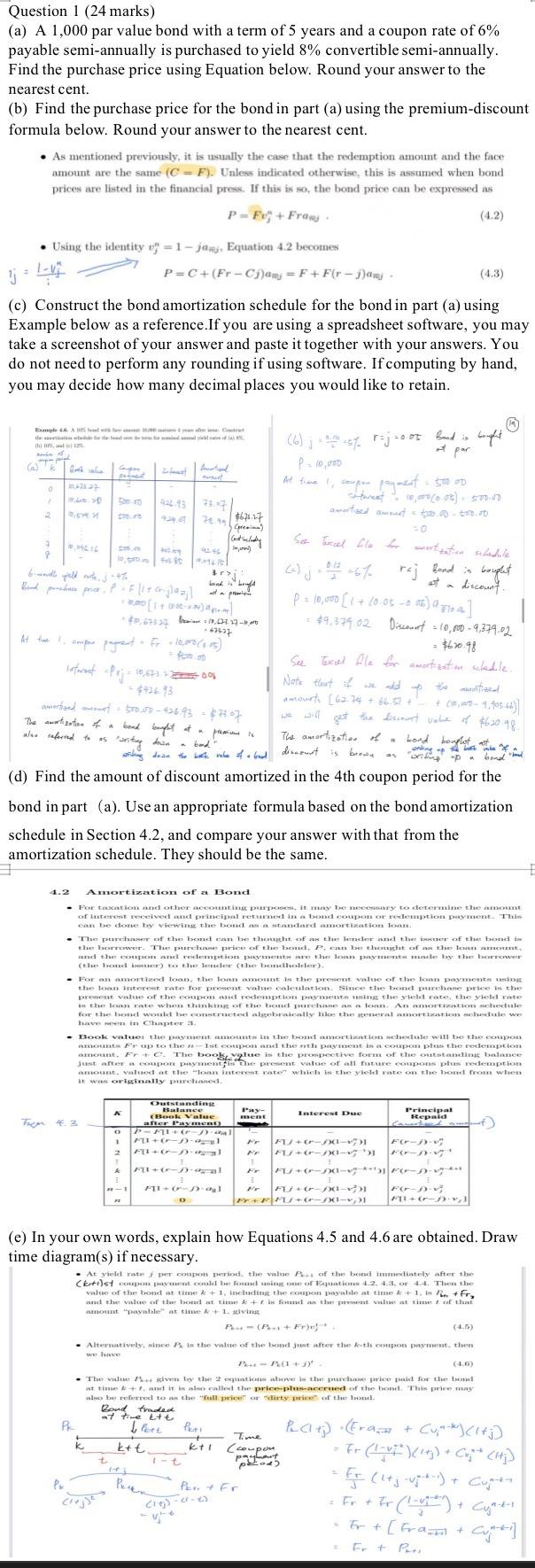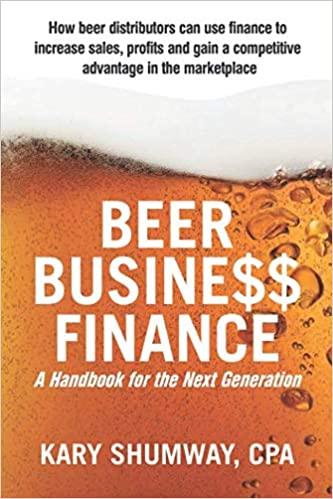
Question 1 (24 marks) (a) A 1,000 par value bond with a term of 5 years and a coupon rate of 6% payable semi-annually is purchased to yield 8% convertible semi-annually. Find the purchase price using Equation below. Round your answer to the nearest cent. (b) Find the purchase price for the bond in part (a) using the premium-discount formula below. Round your answer to the nearest cent. As mentioned previously, it is usually the case that the redemption amount and the face amount are the same (CF). Unless indicated otherwise, this is assumed when bond prices are listed in the financial press. If this is so, the bond price can be expressed as P=Fv+Fram (4.2) . Using the identity 1-ja, Equation 4.2 becomes = (4.3) (c) Construct the bond amortization schedule for the bond in part (a) using Example below as a reference. If you are using a spreadsheet software, you may take a screenshot of your answer and paste it together with your answers. You do not need to perform any rounding if using software. If computing by hand, you may decide how many decimal places you would like to retain. Example & A with the tasted the day (125 d STT () k 0 7 2 1 3 8 A 10.476.27 0,5V X W.04.16 Pr Coupe pravend 500-10 From 4.3 Ph M&year Car of (4) R 2 n 6 dl geld tejith. br>j! is brought Band purchase price, P = F \It crij)a=;] and prom $0,673 27 At tu ampa pagment Fr - 10,00 (105) . P=C+(Fr-Cj)amj=F+ F(r-jam- () j = 0+2=67 P = 10,000 (1 + (0.05 -0.06) a $70.426] | - $9,374.02 Discount = 10,000-9,379.02. = $620.98 See Texiel fle for amortization schedule. Note that of we add up the tized amourth [6274 + 66.57 + = we amortized amount 500.00-426.93 - $75 07 The amortization of a bond bought at a also referred to as writing down a bond" writing down the both vole of a bood will get the discount value of $6.20.98. The amortization of a bond bought a at discount is brown as -onding up the hot ink of "writing up a bond (d) Find the amount of discount amortized in the 4th coupon period for the bond in part (a). Use an appropriate formula based on the bond amortization schedule in Section 4.2, and compare your answer with that from the amortization schedule. They should be the same. interest - Prj = 10,673 +30 - $426.93 k 422.43 9.24 T 4.2 Amortization of a Bond K t # 1 #-1 Am 92-46 domy fus 8C 1961] 72.07 . For taxation and other accounting purposes, it may be necessary to determine the amount of interest received and principal returned in a bond coupon or redemption payment. This can be done by viewing the bond as a standard amortization loan. t . For an amortized loan, the loan amount is the present value of the loan payments using the loan interest rate for present value calculation. Since the bond purchase price is the present value of the coupon and redemption payments using the yield rate, the yield rate is the loan rate when thinking of the bond purchase as a loan. An amortization schedule for the bond would be constructed algebraically like the general amortization schedule we have seen in Chapter 3. 143 The purchaser of the bond can be thought of as the lender and the issuer of the bond is the borrower. The purchase price of the bond, P, can be thought of as the loan amount, and the coupon and redemption payments are the loan payments made by the borrower (the bond isomer) to the lender (the bonelholder). 10.07 17-00,00 -63337 Book value: the payment amounts in the bond amortization schedule will be the coupon amounts Fr up to the n-1st coupon and the nth payment is a coupon plus the redemption amount, Fr + C. The book value is the prospective form of the outstanding balance just after a coupon payment is the present value of all fature coupons plus redemption amount, valued at the "loan interest rate" which is the yield rate on the bond from when it was originally purchased. (Book Value after Payment) O P-MI+ ()al 1 k+t Outstanding Balance $678.27 (premina) God lady Pajaran) F[1+0=1 O FII+ (1)al 1-t K (6) 0% r=j=005 Bond is bright at par Peti P = 10,000 At time , compor payment 500.00 Pay- ment - ktl Fr (1)-(-e) = E E A1+ (rl Fr FU+G-DO-7)(-)- 4 1 1 Fr FU+Gr-Da-1 10,000 (0.00) 500.00 (e) In your own words, explain how Equations 4.5 and 4.6 are obtained. Draw time diagram(s) if necessary. Interest Due FU+(-DX0-71 FU+GJX0-75 T Per + Fr at a discount. Fr+FFU+(xS)(\~v;)] At yield rate per coupon period, the value P of the bond immediately after the (ktist coupon payment could be found using one of Equations 4.2. 4.3. or 4.4. Then the value of the bond at time & +1, including the coupon payable at time k +1. is + Fr and the value of the bond at time k +t is found as the pressent value at time of that amount "payable" at time & + 1. giving Time (coupont (4.5) Alternatively, since P, is the value of the bond just after the k-th coupon payment, then we have PP(1+j) (4.6) The value P. given by the 2 equations above is the purchase price paid for the bond at time &+t, and it is also called the price-plus-accrued of the bond. This price may also be referred to as the "full price" or "dirty price of the bond. Rond traded at time Lt blest Principal Repaid Loudred FG-DV F E FG-D-V FLI+G-D)) P(1+3) (Fra= + (v^-^^)(1+) Fr (1-)(1+j) + Cu+ (Hj) - Fr (1+j-uj-+-1) + Cupt = Fr + Ir (1-0-) + Cut = Fr + [Fra_ + Curti] Question 1 (24 marks) (a) A 1,000 par value bond with a term of 5 years and a coupon rate of 6% payable semi-annually is purchased to yield 8% convertible semi-annually. Find the purchase price using Equation below. Round your answer to the nearest cent. (b) Find the purchase price for the bond in part (a) using the premium-discount formula below. Round your answer to the nearest cent. As mentioned previously, it is usually the case that the redemption amount and the face amount are the same (CF). Unless indicated otherwise, this is assumed when bond prices are listed in the financial press. If this is so, the bond price can be expressed as P=Fv+Fram (4.2) . Using the identity 1-ja, Equation 4.2 becomes = (4.3) (c) Construct the bond amortization schedule for the bond in part (a) using Example below as a reference. If you are using a spreadsheet software, you may take a screenshot of your answer and paste it together with your answers. You do not need to perform any rounding if using software. If computing by hand, you may decide how many decimal places you would like to retain. Example & A with the tasted the day (125 d STT () k 0 7 2 1 3 8 A 10.476.27 0,5V X W.04.16 Pr Coupe pravend 500-10 From 4.3 Ph M&year Car of (4) R 2 n 6 dl geld tejith. br>j! is brought Band purchase price, P = F \It crij)a=;] and prom $0,673 27 At tu ampa pagment Fr - 10,00 (105) . P=C+(Fr-Cj)amj=F+ F(r-jam- () j = 0+2=67 P = 10,000 (1 + (0.05 -0.06) a $70.426] | - $9,374.02 Discount = 10,000-9,379.02. = $620.98 See Texiel fle for amortization schedule. Note that of we add up the tized amourth [6274 + 66.57 + = we amortized amount 500.00-426.93 - $75 07 The amortization of a bond bought at a also referred to as writing down a bond" writing down the both vole of a bood will get the discount value of $6.20.98. The amortization of a bond bought a at discount is brown as -onding up the hot ink of "writing up a bond (d) Find the amount of discount amortized in the 4th coupon period for the bond in part (a). Use an appropriate formula based on the bond amortization schedule in Section 4.2, and compare your answer with that from the amortization schedule. They should be the same. interest - Prj = 10,673 +30 - $426.93 k 422.43 9.24 T 4.2 Amortization of a Bond K t # 1 #-1 Am 92-46 domy fus 8C 1961] 72.07 . For taxation and other accounting purposes, it may be necessary to determine the amount of interest received and principal returned in a bond coupon or redemption payment. This can be done by viewing the bond as a standard amortization loan. t . For an amortized loan, the loan amount is the present value of the loan payments using the loan interest rate for present value calculation. Since the bond purchase price is the present value of the coupon and redemption payments using the yield rate, the yield rate is the loan rate when thinking of the bond purchase as a loan. An amortization schedule for the bond would be constructed algebraically like the general amortization schedule we have seen in Chapter 3. 143 The purchaser of the bond can be thought of as the lender and the issuer of the bond is the borrower. The purchase price of the bond, P, can be thought of as the loan amount, and the coupon and redemption payments are the loan payments made by the borrower (the bond isomer) to the lender (the bonelholder). 10.07 17-00,00 -63337 Book value: the payment amounts in the bond amortization schedule will be the coupon amounts Fr up to the n-1st coupon and the nth payment is a coupon plus the redemption amount, Fr + C. The book value is the prospective form of the outstanding balance just after a coupon payment is the present value of all fature coupons plus redemption amount, valued at the "loan interest rate" which is the yield rate on the bond from when it was originally purchased. (Book Value after Payment) O P-MI+ ()al 1 k+t Outstanding Balance $678.27 (premina) God lady Pajaran) F[1+0=1 O FII+ (1)al 1-t K (6) 0% r=j=005 Bond is bright at par Peti P = 10,000 At time , compor payment 500.00 Pay- ment - ktl Fr (1)-(-e) = E E A1+ (rl Fr FU+G-DO-7)(-)- 4 1 1 Fr FU+Gr-Da-1 10,000 (0.00) 500.00 (e) In your own words, explain how Equations 4.5 and 4.6 are obtained. Draw time diagram(s) if necessary. Interest Due FU+(-DX0-71 FU+GJX0-75 T Per + Fr at a discount. Fr+FFU+(xS)(\~v;)] At yield rate per coupon period, the value P of the bond immediately after the (ktist coupon payment could be found using one of Equations 4.2. 4.3. or 4.4. Then the value of the bond at time & +1, including the coupon payable at time k +1. is + Fr and the value of the bond at time k +t is found as the pressent value at time of that amount "payable" at time & + 1. giving Time (coupont (4.5) Alternatively, since P, is the value of the bond just after the k-th coupon payment, then we have PP(1+j) (4.6) The value P. given by the 2 equations above is the purchase price paid for the bond at time &+t, and it is also called the price-plus-accrued of the bond. This price may also be referred to as the "full price" or "dirty price of the bond. Rond traded at time Lt blest Principal Repaid Loudred FG-DV F E FG-D-V FLI+G-D)) P(1+3) (Fra= + (v^-^^)(1+) Fr (1-)(1+j) + Cu+ (Hj) - Fr (1+j-uj-+-1) + Cupt = Fr + Ir (1-0-) + Cut = Fr + [Fra_ + Curti]







